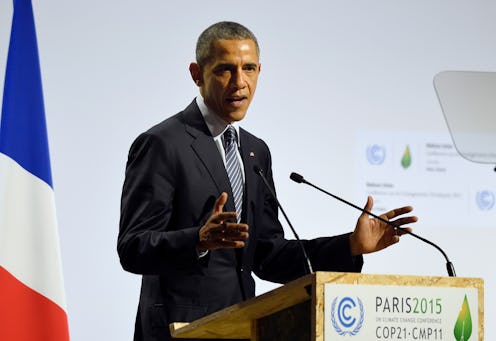News
What You Should Take From Obama's Climate Plan
This week, President Barack Obama attended the climate change talks in Paris, known as COP21. In a speech Monday, Obama admitted that the U.S. has been one of the greatest contributors to industry-driven climate change, according to The New York Times. That's why he's devised a tough plan for the U.S. to help cut carbon emissions and invest in clean energy. If Americans take anything away from COP21 and Obama's comments about climate change, it should be that Obama's climate change plan is realistic and completely achievable.
The most notable aspect of Obama's climate change plan, called the Clean Power Plan, aims to cut carbon emissions in the U.S. by 32 percent — measure by 2005 levels of carbon — by 2030. The plan also requires that power plants use more renewable energy, with the goal of increasing the "generating capacity" of renewable sources from 22 percent to 28 percent, according to the Times. Many states are suing the government or challenging the plans to move more coal-fired power plants to natural gas or renewable energy, and some Republicans have called it a "war on coal," according to the Times. The states are reluctant to submit to Obama's plan because many believe it will cut thousands of jobs, especially in states like Virginia and Wyoming, whose power is generated mostly through cheap coal. But, Obama's plan allows states to create their own plans for reaching emissions targets, and his plan has shown just how investing in renewable energy would create even more jobs, according to the White House webpage for the plan.
The Washington Post wrote an editorial in August praising the plan, calling it the "second-best plan, for both the environment and the economy." Why only second best? Well, because Obama had to compromise on a number of areas to give states flexibility. This should be Americans one big takeaway from Obama's climate change plans: the flexibility forced on him by a Republican-controlled Congress makes the Clean Power Plan completely doable. In some ways, the plan might not actually go far enough.
Obama's plan will give each state specific emissions targets and deadlines to meet them either by switching to more renewable energy or by making their energy use cleaner and more efficient, according to the Post. States that are trying to meet their targets but can't reach deadlines without jeopardizing their power grids' reliability will be able to apply for waivers, according to the Post.
Further, the plan will allow states to sell and buy the ability to pollute. The Post held that this was the most efficient way, economically, to incentivize states to move toward clean energy because it will make sure emissions are first cut in areas where cuts will be the cheapest. Time-wise and economy-wise, the plan is totally achievable. The one worry that both the Post and Scientific American have expressed is that the plan actually doesn't go far enough fast enough.
Though many of the states are suing the government because they believe the Clean Power Plan will hurt their states' coal industries, Scientific American's analysis found that that's actually not true. Because the plan is so flexible on a state-by-state basis, the estimated 1,000 fossil fuel-fired power plants in the U.S. will continue to operate as usual, because they can add efficiency improvements to their operating systems and manipulate the trading system to allow the biggest coal-fired plants to continue producing at their normal rates, according to Scientific American.
"Together, the fossil fuels are anticipated to provide roughly 60 percent of U.S. electricity in 2030, or just 7 percent less than the amount generated from those same fuels in 2014," Scientific American found.
Unfortunately, Obama's plan won't even reach targets set by leading climate change scientists. For example, scientists found that pollution would have to peak in 2020 to avoid the 2 degrees Celsius of warming that could leave irreparable damage on the environment, but 2020 is two years before Obama's plan will even go into effect, according to Scientific American.
Not only is Obama's plan achievable, but Scientific American found that its "tough" measures are cheaper to enact sooner rather than later: "The faster pollution goes down, the less risk of catastrophic climate change." Obama's climate change plans are thus necessary, possible, and maybe not even grand enough.
